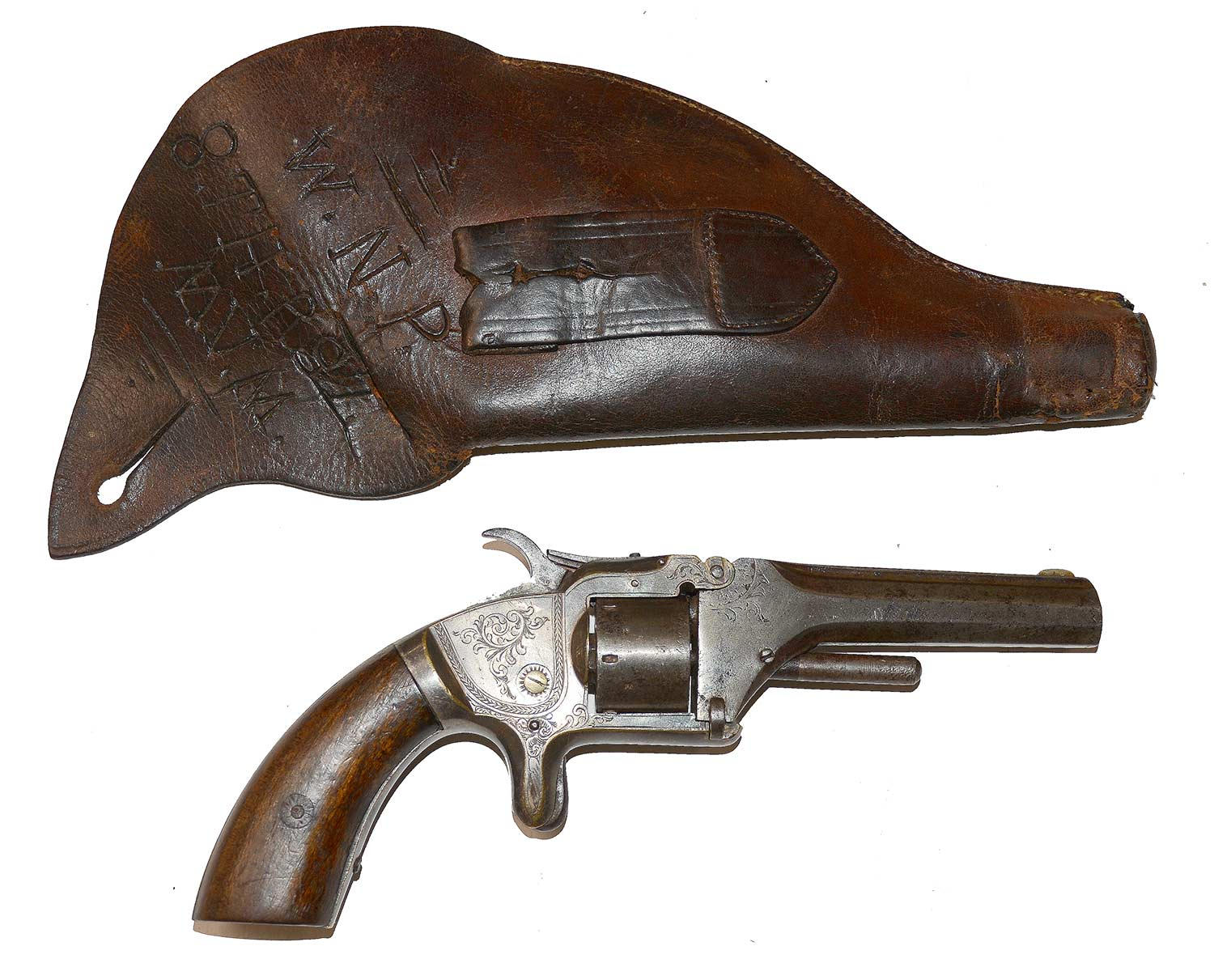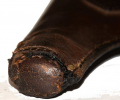site search
online catalog
ENGLISH/BELGIAN COPY OF SMITH & WESSON NO. 1 REVOLVER & HOLSTER IDENTIFIED TO 8TH MINNESOTA INFANTRY

$1,295.00
Quantity Available: 1
Item Code: 2022-986
This is a European (English or Belgian) copy of a Smith & Wesson, No. 1, Second Issue Revolver. It is a .32 caliber, seven-shot revolver with a 4” octagonal barrel, rosewood handles, with extensive floral engraving.
Barrel features blade sight and floral engraving. Two small crown proof marks are found on left side. Clear bore with rifling. Cylinder has engraving around front edge and multiple crown proof stamps all the way around. Frame and back strap are nickel-plated brass. These plated portions of the gun are all extensively engraved with floral patterns. Approximately 90% of plating remains. Barrel, cylinder, and frame share matching assembly numbers (“15”). Mechanics are strong. Usual slight wobble at barrel hinge. Rosewood grips retain an attractive dark patina.
Small leather holster is of one-piece construction sewn along the rear seam with belt loop and nose cap added. Flap has integral closing tab which is cut to close over attached brass finial. Cut into the flap is, “W.N.P. / 8TH RGT / M.V.M.” Leather remains soft and pliable. It appears that the nose cap had come partially unstitched and an unprofessional repair was made using glue. Overall, a very fine holster.
William Paist was commissioned as 2nd Lieutenant of Company H, 8th Minnesota Infantry on October 30, 1862. He was promoted to Captain on May 28, 1865 and muster out of service on July 11, 1865 at Fort Snelling, MN.
The 8th regiment was organized in the summer and fall of 1862. It was sent to the vicinity of the Indian raids, with headquarters at Fort Ripley. Headquarters were established at St. Cloud in the spring of 1863, with the regiment moving to the Sioux frontier. Company H was stationed at Fort Abercrombie and detailed to patrol the frontier. As mounted infantry the regiment joined Sully's expedition against the Sioux in May, 1864. They reached the Bad Lands on August 5. Three days later they were attacked by 5,000 Indians, who were driven for 12 miles, with a loss in killed and wounded of nearly 1,000, the troops losing about 100, only 9 of whom were killed. This battle was called "Waps-Chon-choka" by the Indians. The regiment returned to Fort Snelling and left the state on October 26 for Murfreesboro, Tenn. There it lost 90 in killed and wounded. It was ordered to Columbia and assigned to the 23rd Corps. Then sent to North Carolina. It participated in the battle of Kinston, then joined Sherman's forces.
A solid example of a personal sidearm that was popular with Civil War soldiers. [jet] [ph:L]
~~~~~~~~~~~~~~~~~~~~~~~~~~~~~~~~~~~
THIS ITEM, AS WITH ALL OTHER ITEMS AVAILABLE ON OUR WEB SITE,
MAY BE PURCHASED THROUGH OUR LAYAWAY PROGRAM.
CLICK HERE FOR OUR POLICIES AND TERMS.
THANK YOU!
Inquire About ENGLISH/BELGIAN COPY OF SMITH & WESSON NO. 1 REVOLVER & HOLSTER IDENTIFIED TO 8TH MINNESOTA INFANTRY
For inquiries, please email us at [email protected]
Most Popular
Historical Firearms Stolen From The National Civil War Museum In Harrisburg, Pa »
Theft From Gravesite Of Gen. John Reynolds »
Fine Condition Brass Infantry Bugle Insignia »
Selection Of Unframed Prints By Don Troiani »
Wonderful Condition Original Confederate-Manufactured Kepi For A Drummer Boy Or Child »
featured item
WORLD WAR TWO / KOREA UNITED STATES MARINE CORPS OFFICER’S MAMALUKE SWORD
The drawn sword meas. approx. 36.00 inches long. The blade itself meas. approx. 31.00 inches long x 0.75 of an inch wide at the ricasso. It has a central fuller that starts just above the ricasso and runs for approx. 27.00 inches. The blade surface… (2021-944). Learn More »

















